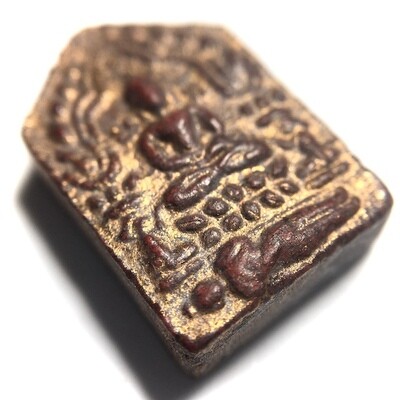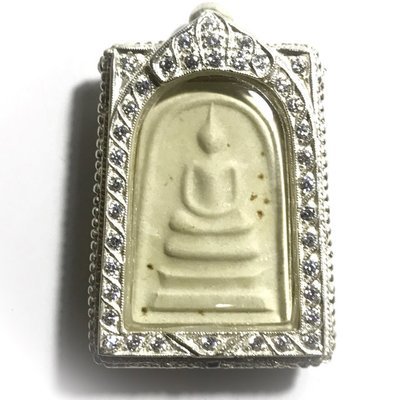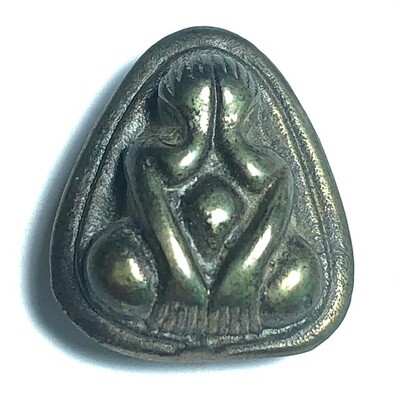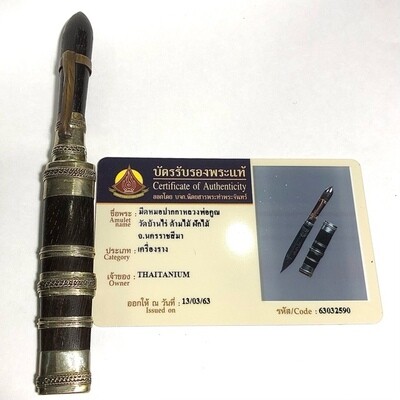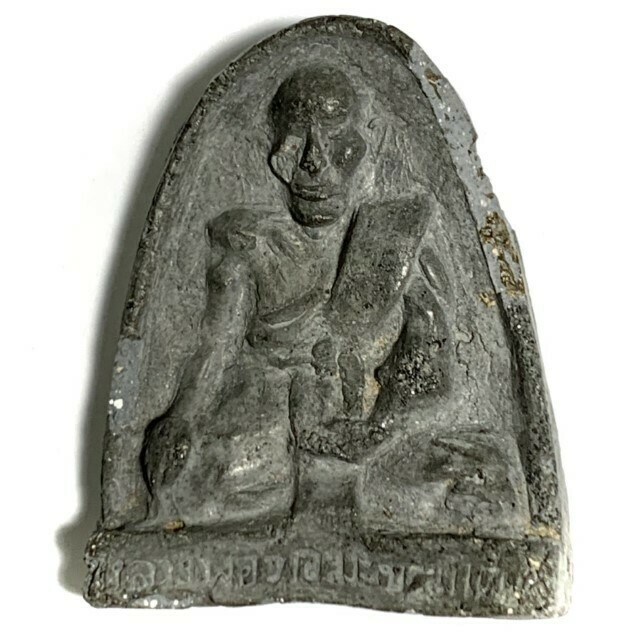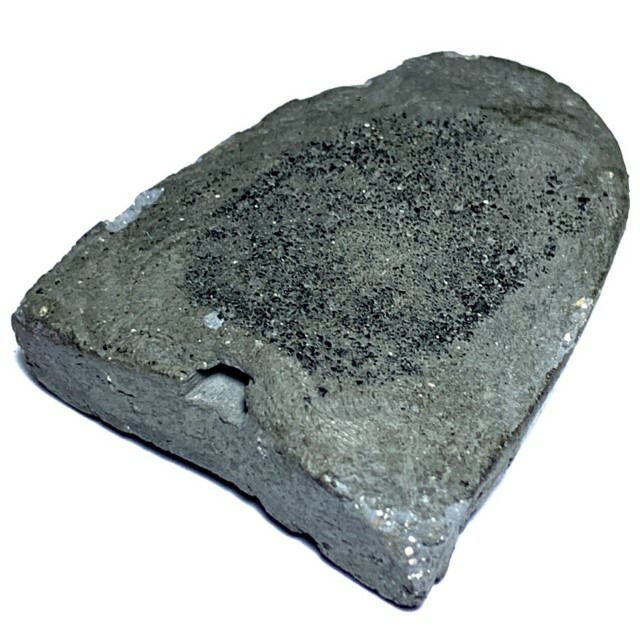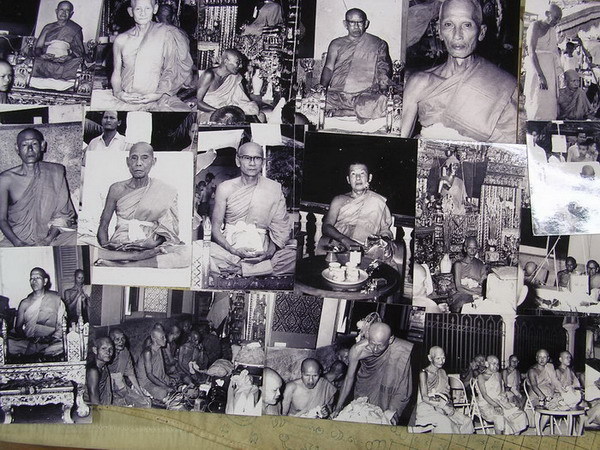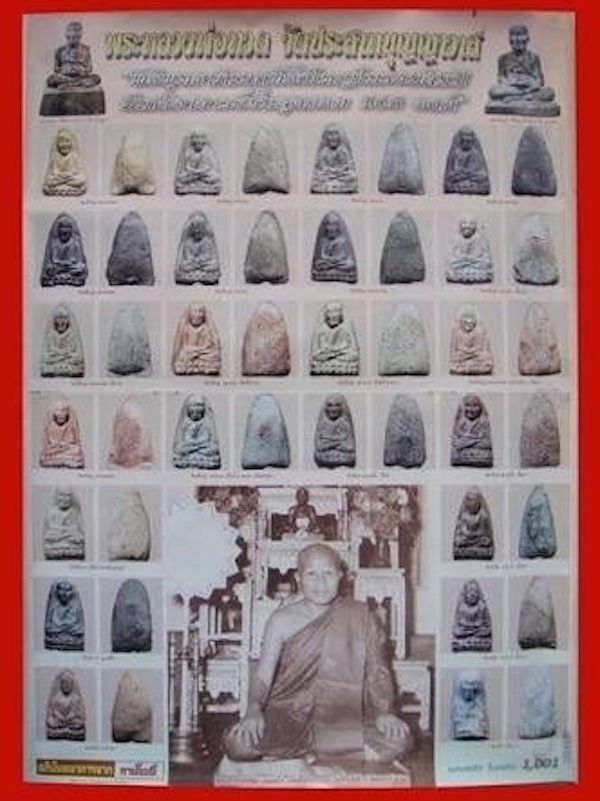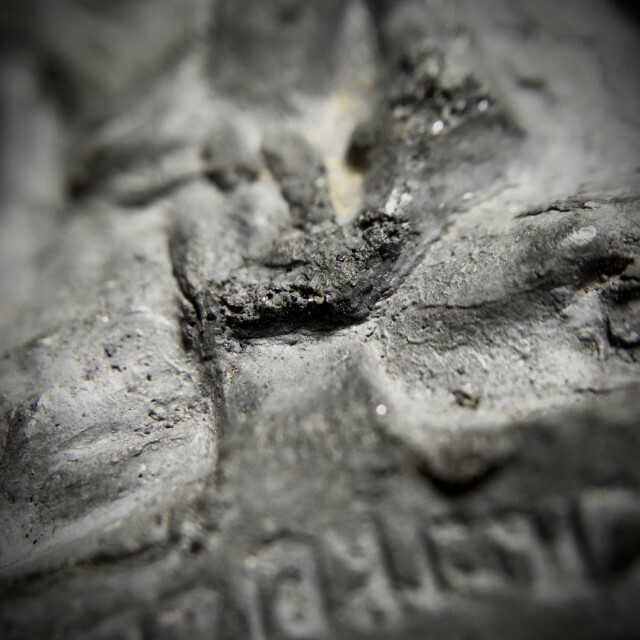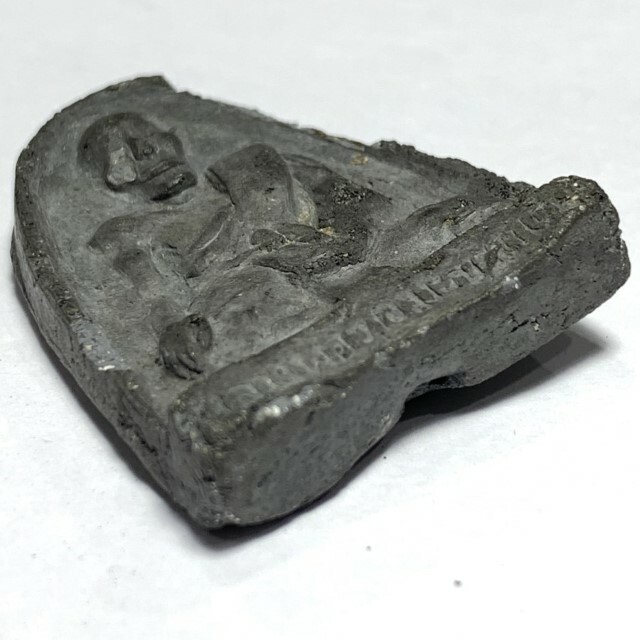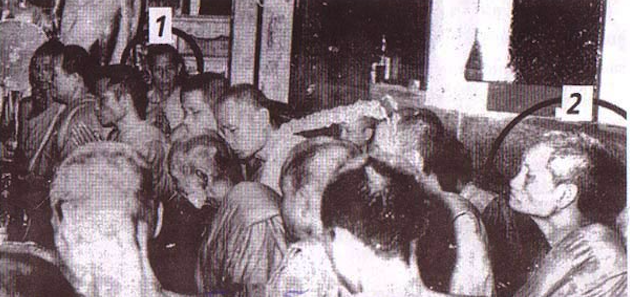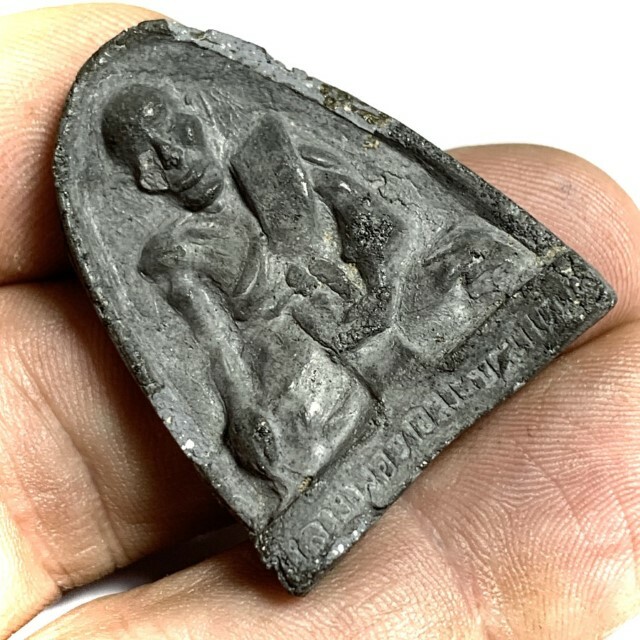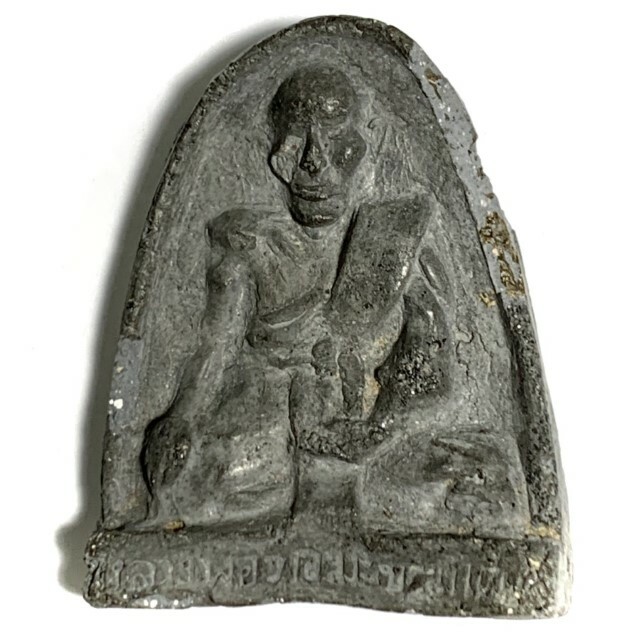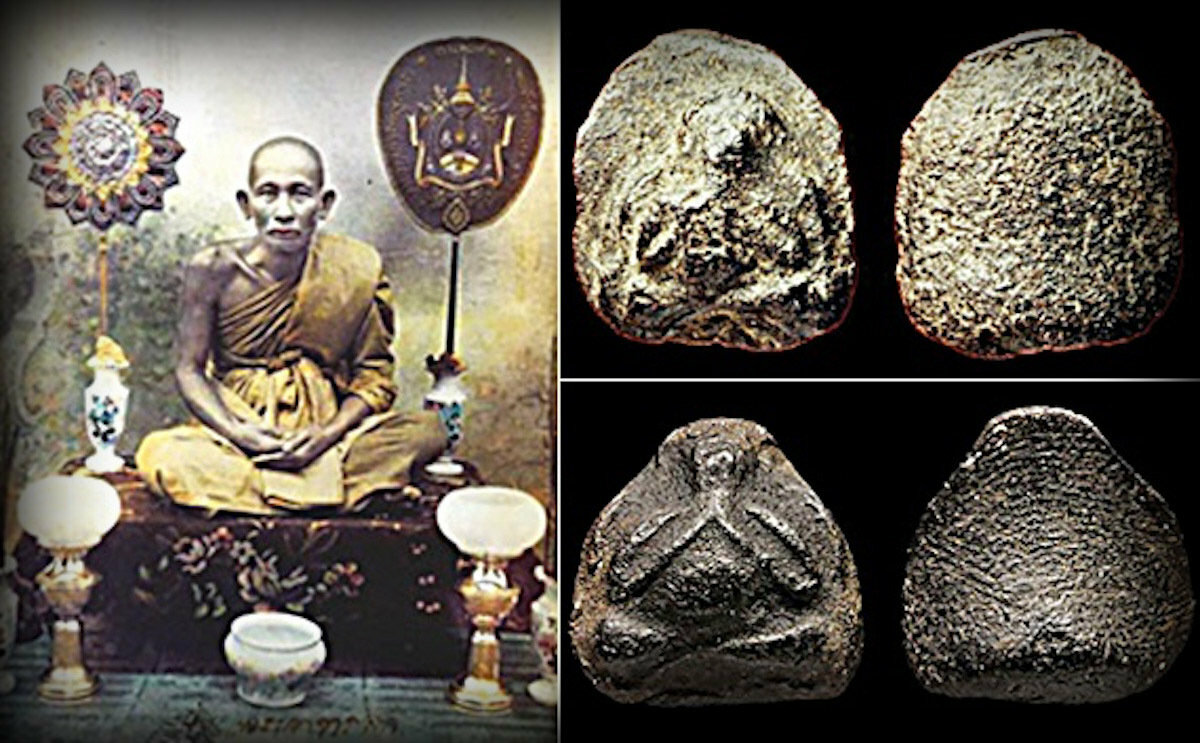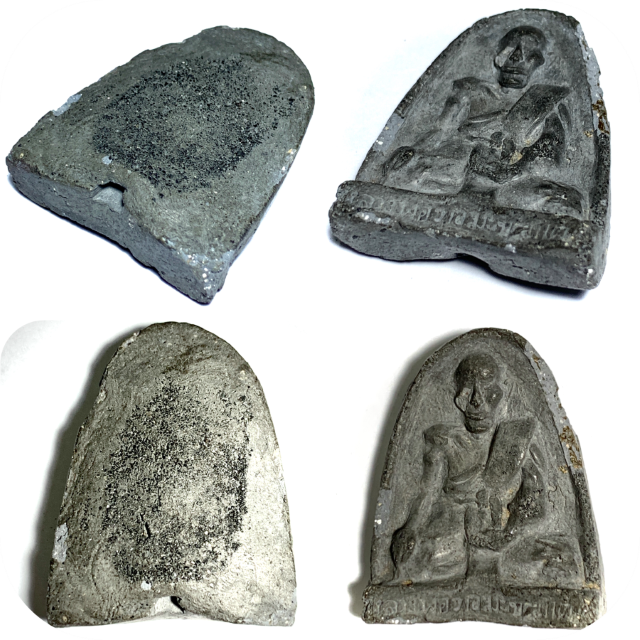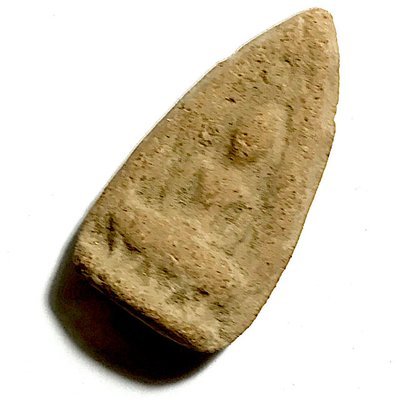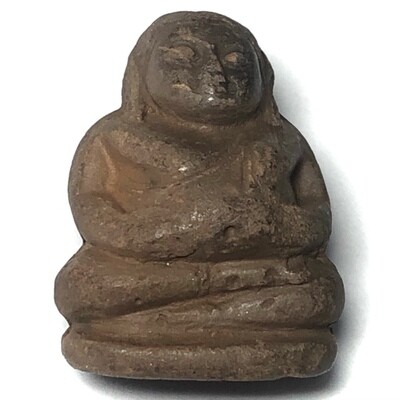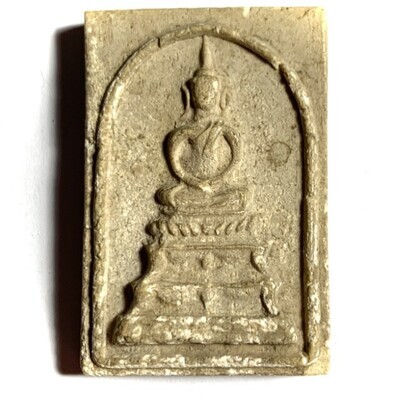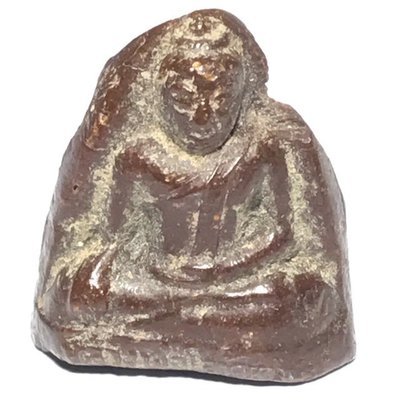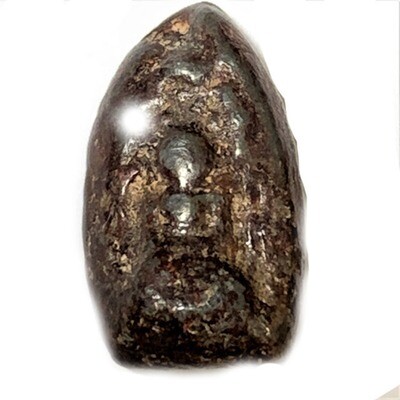Presenting a tiny but powerful and rare classic amulet from one of the Great Khao Or Masters of the 20th Century, Rian Glom Lek Hlang Chedi 2505 BE Nuea Tong Daeng Miniature Guru Monk Coin Por Tan Klai Wajasit
This Sacred amulet of the Great Khao Or Master of Nakorn Sri Tammarat, Master of Wat San Khan and Wat Pratat Noi, is a very rare amulet from Por Tan Klai’s 2505 BE Blessing Ceremony Edition, and is considered a ‘Jaek mae Krua’ type amulet (meaning ‘give to the kitchen maids and temple helpers’), which is suitable not only for men, but due to its miniature size, a perfect amulet for ladies or children to wear.

Rian Glom Lek 2505 BE Por Tan Klai Wajasit Wat Suan Khan
The 2505 BE edition of amulets of Por Tan Klai, is a highly preferred edition, which saw his famous ‘Rian Glom’ round Monk coin amulet with Chakra released, The Rian Glom Lek Hlang Chedi, and the Roop Tai Por Tan Klai Guru Monk Blesséd Photographamulets such as look om chan hmak and ya sen tobacco balls, and sacred powder amulets of various models.
A very rare and highly prized amulet for the devotees of Por Tan Klai to associate with his image and pray to him with a blessed image of the Guru, and the Chedi Relic Stupa on rear face for Buddhanussati and Marananussati. A powerful and Sacred amulet which has passed through the hands of the Guru and been blessed by him.
Por Tan Klai was one of the Top Guru Master Monks of the Last Century, and is considered one of the Four Great Masters of the Previous Generation of Lineage Masters of the Khao Or Southern Sorcery Lineage.
Kata Bucha Por Tan Klai
Pra Pong Roop Muean Luang Phu Sukh Wat Makham Tao 2506 BE Nuea Bailan 2 Blessing Ceremonies 234 Guru Masters Wat Prasat
A rarely seen exhibit of a Pra Pong Roop Muean Luang Phu Sukh Wat Pak Klong Makham Tao Guru Monk Image in Nuea Bailan with Din Kakyayaks, from the Great 2506 BE Wat Prasat Bunyawas Amulet Blessing Ceremony, known as the third largest and most historically important ceremonies in the history of Thai Buddhist Amulet making. A highly revered, and rare Sacred Powder Votive Tablet, which was graced with the presence, and empowerment of 234 Master Monks, over two consecutive Buddha Abhiseka ceremonies.
Free registered air parcel shipping worldwide is included. This model is formed in the image of Luang Phu Sukh is one of various Master Monk images released in this ceremony, such as Luang Por Jong, Luang Por Opasi, and Luang Por Tuad. The images vary greatly in appearance due to hand pressing, and it is difficult to find an exhibit in such clear cut and with such high resemblance and detailed relief as this exhibit, making it a masterpiece of miniature Buddhist Art, and an Ongk Kroo study piece for students of this edition to use as a reference model.
This highly Sacred and extremely rare amulet contains Sacred Muan Sarn and Broken Amulets from first edition 2497 and 2505 BE Luang Phu Tuad Wat Chang Hai Amulets, and a host of other Sacred Powders including the Sacred Din Kakyayaks Holy Peat Marsh Earths from the Holy Marsh, where Luang Phu Tuad would obtain the Sacred Black Magical Earthen Powders.
This model is an extremely well kept Pristine Exhibit, with very clear features, and a classic surface sheen, worthy of competition entry The 2505-2506 BE (1961) Wat Prasat Bunyawas Edition Amulets, is a universally accepted and officially recognized edition of classic Buddhist Amulets, of extremely high esteem.
One reason it is so highly respected as the sacred edition of Amulets, is the fact that the creation of the sacred Muan Sarn Powders for this edition were given extreme attention to detail, and were gathered together over a long period of time, and donated from many great masters.The blessing ceremony for these Amulets is also a historically famous blessing ceremony, for its immensity, and the presence of great powerful guru monks.
The temple of Wat Prasat Bunyawas was built in 2376 BE, and was first given an official boundary and a name in 2379 BE, being first named 'Wat Klong Sam Sen', because it was located over the Sam Sen tributary canal. Its name was later changed to 'Wat Khwid', because of the 2 Sacred Giant Khwid Trees, which stood beside the Uposadha Shrine Room.Later, in the year 2498 Buddhist Era, the temple was burned in a terrible fire. Many of the temple buildings were destroyed, including the Uposada shrine room.
Pra Kroo Samuh Ampol Palawatano, the Abbot at the time, decided to build a new shrine room instead of repairing the ruins of the old one. This was because of a seemingly miraculous event; Luang Phu Tim, the Great Guru Master Monk and Abbot of Luang Phu Tuad's Legendary Wat Chang Hai temple, had had a vision of the great bodhisattva Luang Phu Tuad, Who appeared to him in a dream and told him to go to Bangkok and help to repair a temple which had been burned to the ground.
Luang Phu then traveled up from the south to Bangkok, and started asking around at Way Iam Woranuch, to find out if that had been a fire in any temples lately. When he heard about the great fire burning the temple down, he went to speak with the Abbot Pra Kroo Samuh Ampol.
After having spoken, Luang Phu Tim presented the Abbot with some original 2505 BE Luang Phu Tuad amulets (now one of the two most famous classic top editions of millionaire Amulets of Luang Phu Tuad). He said they should be used to press a block mold for the making of a new series of Amulets to fund the rebuilding of the shrine room and the rest of the temple.
He also donated an amount of the Famously Powerful and Rare 'Din Kakyayaks' Magickal Peat Earth to use as Muan Sarn for the amulets, and some other Muan Sarn remaining from the 2497 BE first ever edition of Luang Phu Tuad amulets. These ingredients were the added to a large array of other Historically Famous Sacred Muan Sarn, including broken sacred amulets from many great Masters, and many very famous miraculous editions of classic Amulets.

Some of the more well known amulets used to break up and mix in with the sacred powders included; Pra Somdej Wat Bang Khun Prohm 2500 BE, and Pra Somdej Wat Bang Khun Prohm 2509 BE (The two most famous classic and expensive editions of Wat Bang Khun Prohm amulets).
As far as the Luang Phu Tuad models of this edition, they were made to place 84,000 of them within the Chedi Stupa, at Wat Bunyawas (this is known as 'Kru' hiding place chamber, used to place amulets for safekeeping and folate to distribution to extend the period of the preservation of the existence of the Buddhist religion).
A Large number of extra Amulets were also made in addition to the 84,000 placed within the Chedi, to hand out to Devotees at the temple, during the blessing ceremony.The Luang Phu Tuad series was completed first and released in the year 2505 Buddhist era. As to the many other different models (such as this Pra Somdej) which were made, they received a second blessing and were released in the year 2506 Buddhist era.
The Edition rceived 3 days and 3 nights of Chanting, from the 6th to 9th of March 2506. The second Ceremony was performed for 4 days and 4 nights, from the 13th to 15th of November 2506. These were handed out to the congregation who came to paste to gold leaf on the Buddha image which was being installed and blessed with the Buddha Abhiseka (opening of the eyes of the Buddha ceremony).
The very same ceremony also installed and consecrated a Buddha footprint image which was also installed in the temple on the same day and covered with gold leaf by the congregation.
Below; 1. Luang Phu To Wat Pradoo Chimplee. 2 - Luang Por Noi Wat Dhamma Sala, along with other Great masters at the Wat Prasat Bunyawas Blessing Ceremony
Four full days and nights of chanting were performed over these amulets by the 234 monks. The ceremony was so massive that it was considered to be the largest and most important sacred blessing ceremony of Amulets, since the great 25 centuries of Buddhism ritual, in the year 2500 Buddhist era.
Luang Phu Sukh
Luang Phu Sukh, is considered one of the Greatest Master Monks in the History of Thai Buddhism, and is believed to have possessed the most powerful sychic abilities, and magical mastery, able to perform amazing miracles. Luang Phu Sukh was born in the year 2390 BE, towards the end of the Reign of His Majesty Rama 5. He was ordained as a Bhikkhu at the age of 22, at Wat Po Tong Lang Nontaburi.
His Upachaya Ordaining Officer was Luang Por Pra Atigarn Cheuy Jantasiri, Abott of Wat Po Tong Lang. He then stayed on at first at the temple to acquire his initial training from Pra Atigarn Cheuy, developing the methods of Vipassana Kammathana, and Kasina Elemental Meditation. After a while, Luang Phu Sukh was able to separate and control each of the ten elemental and formless objects of Kasina Meditation, and Mastered the control of Elemental Magick.
After Mastering these techniques, he traveled on to stay at Wat Sam Ngam Patumwan, to study Pariyatti Dhamma (academics), in order to increase his level of understanding of the more subtle aspects to observe using the Dhamma Eye, when looking within the 5 aggregates in Vipassana Mindfulness Meditation, which of course gives rise to psychic powers as a side-effect of the Enlightenment Process.
It was here that he met up with the great Luang Por Ngern of Wat Bang Klan (Wat Kongkaram), in Pijit, and learn some Wicha with him too. Moving onwards to stay at Wat Chana Songkram in Bangkok, Luang Phu Sukh then practised mastering these more subtle techniques. Luang Phu Sukh thereafter went to develop Wicha at Wat Plab, the temple where all great Masters of History have passed through to pass the test of Mastery of the five raptures meditation, and gain the power to bless amulets with truly powerful Magick.
It is said that it was here at Wat Plab, under tutelage of Pra Sangkarach Maekh, that Luang Phu Sukh performed a Miracle by performing a triple incantatiion upon 3 Banana Tree Flowers, and pointing his wooden staff at them, the flower then turned into a pile of rabbits. Apart from this, Luang Phu Sukh also learned and mastered Wicha Len Prae Taat Elemental and Alchemical Magic, and Magickal metallurgy, with the Great Luang Phu Tap of Wat Anongkaram (Master of Alchemy and maker of one of the top ten Pra Pid Ta, and Cast Metallurgical Amulets of all time).
Luang Phu Sukh at this time also stayed with Somdej Puttajarn Nuam, who was simultaneously developing his Wicha, and was also a born local of Chainat, the Province where LP Sukh was born. Luang Phu Sukh Mastered the Wicha Maekasit Alchemical Mercurial Alloy making methods for Sacred Amulets, which is known to have the power to turn bad things into good things, and change one's luck and fate, improving one's fortunes. The Wicha Len prae Taat of Luang Phu Sukh is hence derived from the Wicha of Luang Por Tap of Wat Anongkaram and the Grimoires of that Temple Lineage. Luang Phu Sukh Liked to travel in solitary or in unison on Tudong in the forests and jungles of Siam in those days, and hence got to cross paths with many great Tudong Masters along the secret paths within the forest which Monks take. He gathered a massive ciompendium of Wicha and mastered them in his solitary forest and cave meditations.
It was during this time that it is said that Luang Phu Sukh developed the natural ability and power to change the elemental constitution of material objects, and to be able to enchant a Tamarind leaf to become a cricket, or turn a person into a crocodile, enchant banana flowers to becomoe rabbits, duck under the water and remain there without breathing for long periods of time, and make a Takrut under thhe water without his robes getting wet. He is also said to have possessed Wicha to make a Hun Payont to use for becoming invisible and teleporting to another place safely. After years of ordination and hard practice on Tudong, Luang Phu Sukh Learned that his Mother was ill, and so he left the forests and went to stay at Wat U-Tong Klong Makham Tao, which was a very ancient Buddhist temple, which lay deep within the mangroves of Klong Makham Tao river.
But the temple was in a terrible state of disrepair on his arrival, that it was impossible to repair anymore. So Luang Phu Sukh decided to begin anew the construction of a completely new temple with new buildings, to replace the unrepairable edifices. The temple was given official recognition and registered as Wat Pak Klong Makham Tao in the year 2447 BE, as Luang Phu Sukh was still liviing, fulfilling his great achievement within his own lifetime. Luang Phu Sukh managed to build various extra edifices for the temple before he passed, such as the Uposatha Shrine-Room, Sala Bprian Dhammma Study Hall, Kuti Huts for Monks, and other important shrines and statues. Luang Phu Sukh's Powerful Magic and Psychic Abilities, and Powerful Spellcasting was renowned around the Nation, to the point where the Great Royal Naval Officer and Courtier Grom Luang Chumporn Khaet Udomsak (Father of the Thai navy), came to beg to become his apprentice (Looksit) in Buddha Magic.
Luang Phu Sukh bestowed his Wicha upon Grom Luang Chumporn, and Grom Luang also took a piece of LP Sukh's Civara Robe to use and make Pha Yant with for soldiers to carry on them, to test the powers of gunstopper magic of Luang Phu Sukh. The results were indeed miraculous in the number of lifesaving miracles that Luang Phu Sukh's amulets have become amongst the most highly sought after of all time for their power of Kong Grapan Klaew Klaad Maha Ud, maha Amnaj and Serm Yos Serm Duang, for Professional Advancement, and Commanding Power, with Invincibility Magick.
Luang Phu Sukh had many Wicha such as the Wicha Suea Saming, able to transform into a Tiger, and the Wicha Look Pern Sakot, which was to perform incantations into a bullet of a single shot firing gun, and the bullet would always find its mark on target, without fail. One could say that Luang Phu Suk is one of the greatest masters of the History of Thai Guru Monks, and is one of the top Ten Legendary Monks of all time. There are so many legends told about his miraculous powers and feats. His Mastery of Traditional healing and herbal Medicine has led his written works on the subject to become the greatest Thai Occult herbalism Recipe Grimoire in all existence. He was the Kroo Ba Ajarn of a great number of the most powerful Master Monks of the last Century, and his powerful Magic remains second to no other Guru Monk in Thai History.
Luang Phu Sukh Passed Away on 23rd December 2466 BE at age 75 after 50 years of ordained life, leaving behind the legends of his Miraculous abilities, and perhaps more devotees in the present day, than even when he was alive. Luang Phu Sukh is most certainly one of the top ten Masters of all time in Thai Buddhist History, and especially famous for his Rian Prapha Mondon Khang Rasamee, Pid Ta Pum Bpong, and his Powerful Takrut scroll spells.
Below; LP Sukh with the classic Pra Pid Ta Pum Bpong amulets
The amulets, and images of this, perhaps the greatest of all Master Monks with Wicha Akom, are amongst the most sought after and valued in the world of Thai Buddhist Amulets. Be it his Rian Roop Muean, Somdej Rasamee Kru Klong Khom, and Somdej Prapa Mondon Khang Rasamee, or his Pra Pid Ta, Prok Bai Makham, Takrut, Prakam Rosaries, and other Talismanic Charms, the spiritual value and magical power is equally regarded as being of the most powerful and truly magical amulets one could possess.
Below; Grom Luang Chumporn
It is said that Luang Phu Sukh became the Kroo Ba Ajarn of Grom Luang Chumporn, a Royal Courtier, an Admiral, and a Great Sorceror of his time. This happened as Grom Luang Chumporn's navy boat had broken and he was forced to park the boat close to Wat Pak Klong Makham Tao. Grom Luang went to make reverence to Luang Phu Sukh, by pretending that he was just a simple commoner, and not a member of the Lordly Family, but Luang Phu Sukh addressed him by his name, surprising Grom Luang Chumporn. Grom Luang Chumporn asked Luang Phu Sukh how he knew who he was?Luang Phu Sukh told him that he saw his Aura approaching, and that it was brighter than that of the normal commoners, and that it told him already who he was. Grom Luang Chumporn asked to learn Wicha with Luang Phu Sukh, and was bestowed with many Magical Wicha, such as the ability to remain under the water for hours and breathe as if he was on land.
Kata Luang Phu Sukh
Sadthā Tēwa Manussānang Puttō Pakawādti Ma-A-U
Kata Maha Sanaeh Luang Phu Sukh
Agkhōhamassami Lōkassa Idti Bpāramidtādtingsā Idtisappanyū Mākadtā Idti Pōti Manubpadtō Idtibpisō Jadtē Namō Arahang Lāpō Puttō Lāpang Nachā Lidti Na Ma Pa Ta Sappē Chanã Pahū Chanā Rāchā Bpurisō Idthīyō Māpang Ēhi Jidt-Dtang Bpiyang Ma-Ma Ēhi Mārē Sōmāmā Ākajchāya Ākajchāhi
